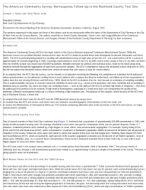
An official website of the United States government
Here’s how you know
Official websites use .gov
A .gov website belongs to an official government organization in the United States.
Secure .gov websites use HTTPS
A lock (
) or https:// means you’ve safely connected to the .gov website. Share sensitive information only on official, secure websites.
-
//
- Census.gov /
- Census Working Papers /
- The ACS: Nonresponse Follow-Up in the Rockland County Test Site
The American Community Survey: Nonresponse Follow-Up in the Rockland County Test Site
The American Community Survey: Nonresponse Follow-Up in the Rockland County Test Site
Introduction
The American Community Survey (ACS) is the major vehicle in the Census Bureau's proposed Continuous Measurement System. While the decennial census has provided detailed socioeconomic data, the ACS is slated to provide these data throughout the decade (Alexander and Davis, 1997). The ACS is presently being tested in a monthly self-administered survey at eight sites across the U.S., and current plans call for a survey of approximately 40 counties beginning in 1999. Coverage would extend to most of the U.S. by 2001 and to every county in the U.S. by 2003, by which time the monthly sample size would total 250,000 households. Reliable estimates for political and statistical areas, down to the block group level, would be derived through the aggregation of data from successive samples. The ACS is intended to replace the decennial census long-form in 2010, but will not replace the decennial census short-form, which will remain the sole source of data for census blocks.
In its simplest form, the ACS, like the census, can be viewed as an operation involving the following: the compilation of a detailed list of addresses1 where questionnaires can be delivered; mailing forms to each address with a request that they be mailed back; and follow-up of non-respondents to collect data that are missing (Ericksen and DeFonso, 1993). Much of the ACS evaluation, thus far, has focused on estimates of sampling variability.
This is understandable, because of concerns about the reliability of small area (e.g., census tract) estimates, and since variability due to sampling is relatively easy to quantify. Yet, there are major non-sampling issues — such as the ability of the ACS to achieve high levels of response — that must be addressed if its promise is to be realized. A high level of nonresponse, especially at a small area level, can compromise the quality of the estimates. Effective nonresponse follow-up is a key to achieving a high response rate. The purpose of this analysis, which focuses on the ACS test site in Rockland County, is three-fold:
- to compare the mail return rates for the ACS and the 1990 decennial census by census tract;
- to examine how the ACS and census mail return rates are related to sociodemographic characteristics at the tract level; and
- to assess the effectiveness of nonresponse follow-up. This involves comparing allocation rates at the tract level, in the ACS and census, on major socioeconomic variables.
Others in Series
Working Paper
Working Paper
Working Paper
Share
Some content on this site is available in several different electronic formats. Some of the files may require a plug-in or additional software to view.
 Yes
Yes
 No
NoComments or suggestions?


Top

